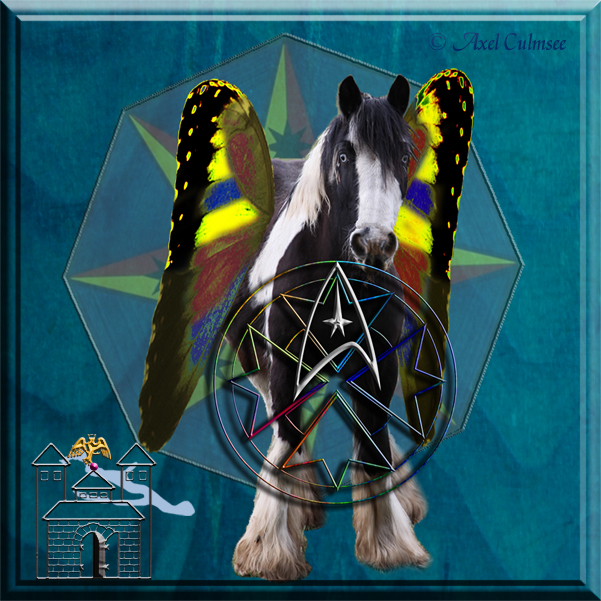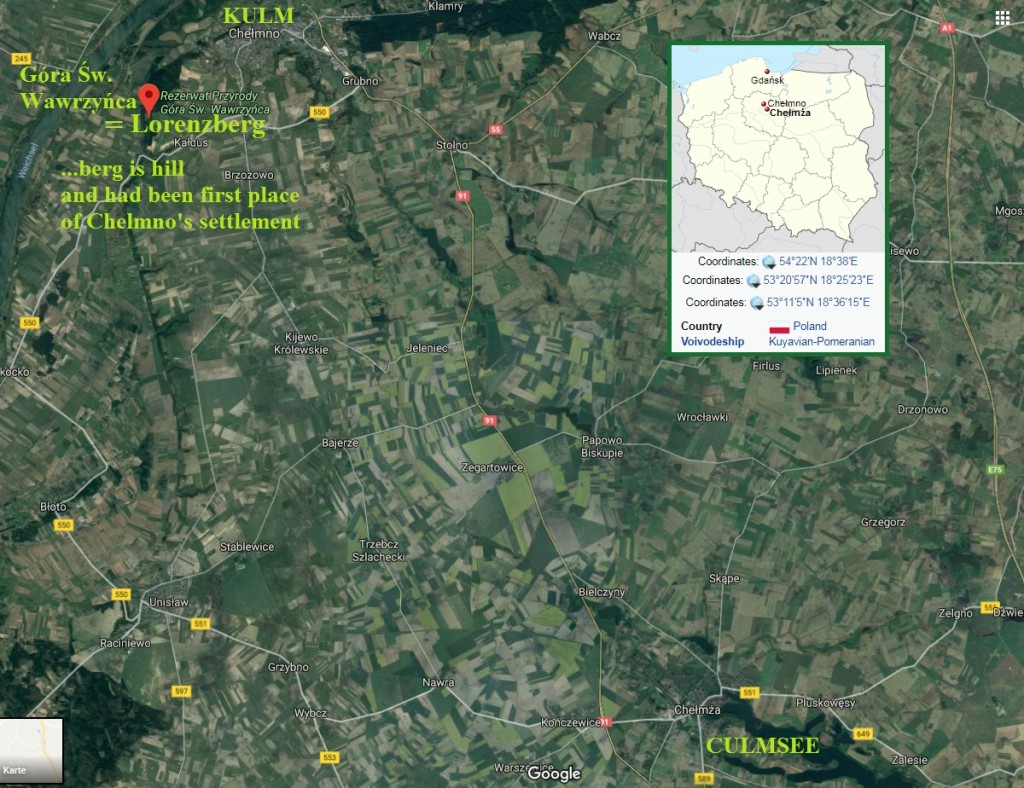
names‘ origin of CulmSEE,
LAKE at Chelmza
Name(n) – Ursprung
Origin of … name(s)
onomastics / Onomastik / Onomasiologie
Culmsee / Kulmsee / Kulm / Culm / Chełmno / Chełmża
…and the Lake…

a compilation of facts / data /
exchange of ideas / flights of thought / brainwaves …
a millennium ago…:
fortress on hilltop became town with resettlement and expansion towards lake nearby,
Synopsis

Chełmno
Chełmża
What about the orign of Kulm…?
Was ist der Ursprung von Culm…?
Folglich suchen wir im Verbund Geowissenschaft / Namenskunde.
Und die Stadt (ehemals) Culmsee, heutiges Chełmża in Polen, ca. 150 km südlich von Danzig gelegen, 20 km nördlich von Thorn, Chełmża selbst bekam 1251 Stadtrechte, also etwa zwei Jahrzehnte nach Chełmno (1233), wenngleich das alte Kulm Anfang 12__ mit dem Bistum Kulm gegründet worden war.
weniger Details / fewer details at: https://en.wikipedia.org/wiki/Che%C5%82mno
Therefore we do research at composite geoscience / onomastics.
And the town of (former days) Culmsee, today’s Chełmża at Poland, located approx. 150 km south of Gdańsk, 20 km north of Toruń, itself in 1251 got city rights, thus two decades later than Chełmno (in 1233), though the old Kulm in early 12__ had been founded with the Bishopric Kulm.
culmen:
dorsal ridge of a bird’s bill / ein Teil des Schnabels vom Emu
ridge implicates hills… / Bergrücken einbezieht Hügel
alles ist mit allem in der Wissenschaft verbunden /
town of Chelmno (approx. 30 km north of Chelmza [where I stopped in 2001, too])
… by the way (inhabitants) Hamburger/Berliner here is a human, no food 😉 approximate to „namesake“ but completely different, just now humas 😉
Was ist mit dem Nachnamen Culmer / Kulmer …
Nebenbei sind die (Einwohner) Hamburger / Berliner hier menschlich, kein Essen 😉 … etwa wie „Namensvetter“, aber komplett verschieden, eben wie Menschen 😉
research
the Lake today named „Jezioro Chełmżyńskie“ itself at Wikipedia
forwards to / is linked to
Jezioro Chełmżyńskie is the Polish name of a lake located at the town of Chełmża in Toruń County, Kuyavian-Pomeranian Voivodeship, Poland. Both, town and lake former days (up to 1945) were named in German: Culmsee. The ending …see means Lake / Jezioro. Therefore in 1251 the lake became eponym of the town.
The lake is up to 6 km long, width up to 0,5 km, up to 27 m deep, has an area of 2,7 km².

historical landscape named Kulmer land (= area) at EN.Wikipedia linked to Chełmno Land
https://de.wikipedia.org/wiki/Kulmerland
erklärt,
dass „Kulm“ aus dem Slawischen stammt, nämlich dem Wort „chlm“, welches einen Hügel bezeichnet und quasi eingedeutscht als „Kulm“ übernommen wurde. Als Ortschaft „Kulm“ lag es ursprünglich am nahegelegenen „Lorenzberg“ (= Góra Św. Wawrzyńca).
explains
that „Kulm“ stems from slavish „chlm“ that denotes a hill and quasi had been germanized as „Kulm“. As village „Kulm“ originally lay at proximate „Lorenzberg“ (= Góra Św. Wawrzyńca).
…but what about hill or hills? well Chelmza’s/Chelmno’s area actually is plain land in driving through…!
[self experienced in 2001]
Was ist mit Hügel oder Hügeln? nun, Chełmża’s / Chełmno’s Umland ist flaches Land beim Hindurchfahren…!
search results: Kulm (Geographie)
>>Kulm steht allgemein für den Gipfel eines Berges, speziell für einen Kegelberg oder eine Kuppe. …<<according to
https://de.wikipedia.org/wiki/Kulm_(Geographie)
https://de.wikipedia.org/wiki/Kulm_(Geographie)#Polen
e.g. Chelmno
searching for „Kulm“ at
https://en.wikipedia.org/wiki/Kulm
displays various but
look at
https://en.wikipedia.org/wiki/Culm
with disambiguation
or at
https://en.wikipedia.org/wiki/Kulm
but interesting „2nd“ „Kulm (town)
https://de.wikipedia.org/wiki/Kulm_(Saalfeld)
located nearby Saalfeld (Thüringen) = Germany: the Free State of Thuringia
explaining a 481 meters high hill …
well, the roots might go deeper… in time, before our known ancestors.
another direction, 30km too, is located town of Bromberg and …berg means …hill (today’s Bydgoszcz).
… and at Lorenzberg since 7th century settlements are known. bishopric / diocese Kulm [German: Bistum Kulm] founded in the land of the hills at river Vistula (German: Weichsel). and that’s too another reason to keep the name Kulm… reasonned by topographical area of political and tactical interest Kulm… and the Hanseatic League (German: Hanse) in 13th century had been of importance there, too, and remained over the centuries the towns name’s dimension(s).
(Góra Św. Wawrzyńca) had been the first location of Kulm/Culm/Chelmno in a distance of a few kilometers only.
Zusammen mit Elbing und Thorn war Danzig die führende preußische Hansestadt.
https://de.wikipedia.org/wiki/Danzig#Hansestadt
river [German] Weichsel = Vistula [geographic]
Together with (towns of) Elbląg and Toruń [German: Elbing, Thorn] Gdansk had been been leading Prussian Hanseatic cities.
https://commons.wikimedia.org/wiki/File:Chelmno_2001_June.jpg
górze św. Wawrzyńca
this link from Chełmno PL „Historia“-site the hill:
https://pl.wikipedia.org/wiki/G%C3%B3ra_%C5%9Awi%C4%99tego_Wawrzy%C5%84ca_(Ka%C5%82dus)
just watch this great proof at Wikipedia of the hill !
averment: here’s the proof picture from „Rezerwat“,
hill picture:
https://pl.wikipedia.org/wiki/Plik:Gora_Sw._Wawrzynca_kolo_Chelmna_(2).jpg
Wawrzyńca = Lorenz / Lawrence
according to „Pons“ and
https://pl.wikipedia.org/wiki/Wawrzyniec_z_Rzymu









